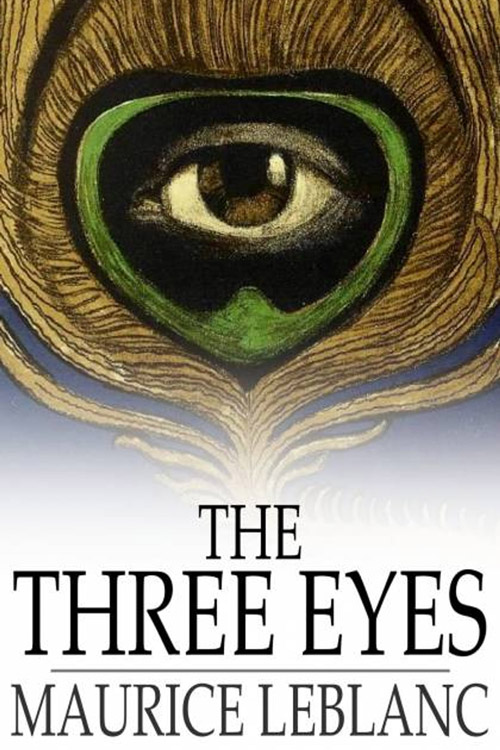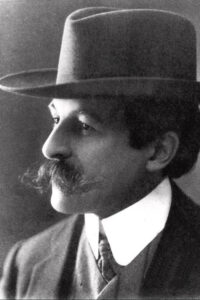
The Three Eyes
For me, the strange story dates back to that autumn day when my uncle Dorgeroux appeared, staggering and unhinged, in the doorway of my room in his house, Haut-Meudon Lodge.
None of us had set eyes on him for a week. A prey to that nervous exasperation into which the final test of any of his inventions invariably threw him, he was living among his furnaces and retorts, keeping every door shut, sleeping on a sofa, eating nothing but fruit and bread. And suddenly, he stood before me, livid, wild-eyed, stammering, emaciated, as though he had lately recovered from a long and dangerous illness.
He was altered beyond recognition! For the first time, I saw him wear unbuttoned the long, threadbare, stained frock coat which fitted his figure closely and which he never discarded even when doing his experiments or arranging on the shelves of his laboratories the innumerable chemicals which he was in the habit of employing. His white tie, which, by way of contrast, was always clean, had become unfastened, and his shirt front was protruding from his waistcoat. As for his good, kind face, usually so grave and calm and still so young beneath the white curls that crowned his head, its features seemed unfamiliar, ravaged by conflicting expressions, no one of which obtained the upper hand over the others: violent expressions of terror and anguish in which I was surprised, at moments, to observe gleams of the maddest and most extravagant delight.
I could not get over my astonishment. What had happened during those few days? What tragedy could have caused the quiet, gentle Noël Dorgeroux to be so utterly beside himself?
“Are you ill, uncle?” I asked anxiously, for I was exceedingly fond of him.
“No,” he murmured, “no, I’m not ill.”
Read or download Book
Maurice LeBlanc
Maurice Marie Émile Leblanc (11 December 1864 – 6 November 1941) was a French novelist and writer of short stories. He is best known for creating the fictional gentleman thief and detective Arsène Lupin, who is often described as a French counterpart to Arthur Conan Doyle’s Sherlock Holmes.
Biography.
The first Arsène Lupin story appeared in a series of short stories that was serialized in the magazine Je sais tout, starting in No. 6, dated 15 July 1905. Created at editorial request, Leblanc may have also read Octave Mirbeau’s Les 21 jours d’un neurasthénique (1901), which features a gentleman thief named Arthur Lebeau, and he had seen Mirbeau’s comedy Scrupules (1902), whose main character is a gentleman thief.
By 1907, Leblanc had graduated to writing full-length Lupin novels, and the reviews and sales were so good that Leblanc effectively dedicated the rest of his career to working on the Lupin stories. Like Conan Doyle, who often appeared embarrassed or hindered by the success of Sherlock Holmes and seemed to regard his success in crime fiction as a detraction from his more “respectable” literary ambitions, Leblanc also appeared to have resented Lupin’s success. Several times, he tried creating other characters, such as private eye Jim Barnett but eventually merged them with Lupin. He continued to pen Lupin tales well into the 1930s.
Leblanc also wrote two notable science fiction novels: Les Trois Yeux (1919), in which a scientist makes televisual contact with three-eyed Venusians, and Le Formidable Evènement (1920), in which an earthquake creates a new landmass between England and France. Leblanc was awarded the Légion d’Honneur for his services to literature and died in Perpignan in 1941. He was buried in the Montparnasse Cemetery. Georgette Leblanc was his sister.
Life
Maurice Leblanc was the second child of Émile Leblanc, a 34-year-old ship-owner merchant, and of Mathilde Blanche (née Brophy), daughter of rich dyers, aged 21 and was delivered by Achille Flaubert, Gustave Flaubert’s brother. He had an elder sister, Jehanne (born in 1863), and a younger sister, Georgette Leblanc (born in 1869), who, from 1883 until the 1920s, was an actor and star operatic soprano. During the Franco-German War of 1870, his father sent Maurice to Scotland. Upon his return to France, he completed his studies in Rouen. The young Maurice received his first education in a free institution, the Patry Pension. Then, from 1875 to 1882, he completed his secondary studies at the Lycée Corneille. As a teenager, he frequently encountered Gustave Flaubert and Guy de Maupassant.
Refusing the career his father intended for him at a card factory, Maurice headed to Paris in 1888 to pursue writing instead. First a journalist, then a novelist and storyteller. His first novel, “Une femme” (A Woman), published in 1893, was very successful and was followed by other works, such as “Des Couples” (The Couples), “Voici des Ailes” (Here Are Wings) and his only play, “La pitié”, released in 1902, which is a failure, causing him to give up the theatre for a while. In 1901, he published “L’Enthousiasme”, an autobiographical novel.
In 1905, Pierre Lafitte, the director of the monthly Je sais tout, commissioned a short story from Leblanc in the vein of A.J Raffles by Ernest William Hornung and the adventures of Sherlock Holmes. The resulting “L’Arrestation d’Arsène Lupin” (The Arrest of Arsène Lupin) was a great public success. Two years later, the book Arsène Lupin, Gentleman Burglar was released, containing the first nine stories depicting the character published in the French magazine ‘Je sais tout’. The following book, Arsène Lupin versus Herlock Sholmes, a second collection of Arsène Lupin stories written by Maurice Leblanc, angered the Sherlock Holmes creator Conan Doyle, who saw Leblanc’s Herlock Sholmes and Wilson as parody characters designed to ridicule Doyle’s work.
Maurice Leblanc received the Legion of Honor on January 17, 1908, presented by then Under-Secretary of State for Fine Arts, Étienne Dujardin-Beaumetz. While a supporter of French radical socialists and free-thinker in his early age, Leblanc became more bourgeois during the First World War. Leblanc would start to grow weary of writing Arsène Lupin stories. As early as 1910, he tried to kill his hero in the story “813” but would resurrect the character in The Crystal Stopper.






